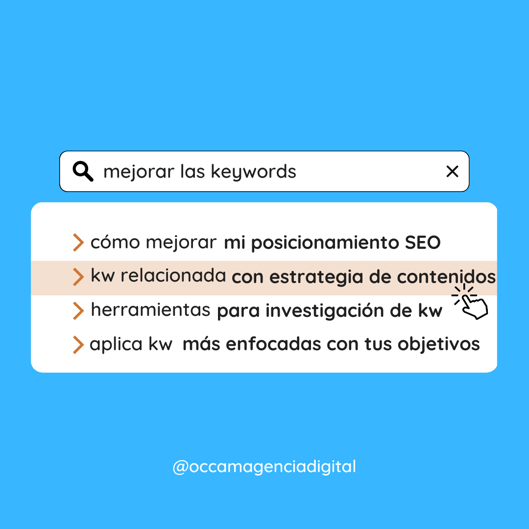Index Content
We know that an important part of SEO is keyword research, as this will help you determine what terms and phrases you should use in your content so that it is more easily found by users. However, there are many complications to getting a list of keywords that really work for your website. We have developed this blog with tips on how to break down keyword research that will be useful and successful for you.
Proper keyword research can help you achieve all of these goals and more. By better understanding your audience and what terms they are searching for, you can create content that is more relevant to them and more likely to be found. This in turn can help you attract new visitors and increase your sales.
Steps to conducting keyword research:
- First of all, the first thing is to identify what your website or business is about - what do you offer? What kind of content do you have on your site?
- We can come up with a list of relevant keywords, using tools such as Google Ads Keyword Planner orAhrefs to find popular keywords related to your topic to help us monitor this task. You can also make a list of keywords based on questions that your customers or users might ask about your product or service.
- Prioritise your keywords. Use tools such as Ahrefs or SEMrush to determine the search volume and difficulty of each keyword. This process will help you determine which of your keywords are most important and you should focus on them first.
- Use your keywords in your content. Make sure you use your keywords naturally in titles, subtitles and content on your site. You should also make sure your keywords are present in the meta description and title tags of your pages, as this can help improve your search engine rankings.
- Monitor your results - use keyword ranking tracking tools to see how your keywords are performing and to determine if you need to make adjustments to your SEO strategy.
Keep in mind that SEO is an ongoing process and you must be willing to adapt and update your strategy as search engine trends and algorithms change . If you follow these steps and devote time and effort to keyword research, you should see your site perform better in search engines and increase.
In addition, by using relevant keywords in your advertising campaigns, you can reach a more targeted audience that is more likely to be interested in what you offer. And by increasing the visibility of your website and your brand in search engines, you can improve your brand recognition and increase the trust of your customers and prospects.
Applying keywords naturally to the content of your site and in the title and meta description tags of your pages is necessary. However, it is important to keep in mind that the content of your site should be first and foremost for your users, not for search engines. This means making sure that the content is quality and relevant to your users, and not just artificially stuffing your site with keywords.
Overuse of keywords, known askeyword stuffing, can be penalised by search engines and can damage the user experience. Therefore, you need to find a balance and use your keywords in a natural and relevant way in your content. SEO and content marketing are closely related, the success of one often depends on the quality of the other. SEO focuses on optimising the content and structure of your website so that it is more easily found by search engines, while content marketing focuses on creating and promoting valuable content to your audience.
With good keyword research, for blog article content, along with blog content that contains quality content, we can determine which terms and phrases you should use in your content so that it is more easily found by your users. When doing keyword research for content marketing, it is important to focus on the needs and interests of your audience and current trends, to create valuable and relevant content for your users, which will increase web visibility and user traffic.
Keyword research helps you answer these questions and better understand your audience and their needs. By doing keyword research, you can determine what terms and phrases people are searching for and in what format they prefer to receive information. You also discover how difficult it is to rank for those specific queries. This can help you prioritise your keywords and focus on those that are most important and relevant to your audience and have the greatest potential to generate traffic and conversion.
An effective keyword strategy should include a combination of long-tail, medium-tail and short-tail keywords.
- Long tailkeywords are more specific and detailed phrases that tend to have less search volume, but also less competition and therefore can be easier to rank for .
- Medium-tailkeywords are more generic and broad terms that have intermediate search volume and higher competition .
- Short tailkeywords are very generic and popular terms that have a high search volume and high competition.
When creating akeywordstrategy, it is important to focus on long-tail and medium-tail keywords in addition to the short-tail keyword, as this will help you attract a wider audience and generate long-term traffic. In addition, it is important to remember that topical relevance is key to SEO and that you should demonstrate your expertise in relevant topics by creating a lot of high quality content on topics related to your business. This will help you improve your search engine rankings and attract a wider and more engaged audience.






